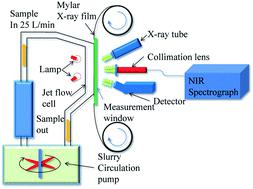当前位置:
X-MOL 学术
›
Anal. Methods
›
论文详情
Our official English website, www.x-mol.net, welcomes your
feedback! (Note: you will need to create a separate account there.)
On-stream mineral identification of tailing slurries of tungsten via NIR and XRF data fusion measurement techniques.
Analytical Methods ( IF 2.7 ) Pub Date : 2020-06-18 , DOI: 10.1039/d0ay00322k Qingya Wang 1, 2, 3 , Fusheng Li 1, 2 , Xiaoyu Jiang 1, 2 , Shuangliang Wu 3 , Muqiang Xu 4
Analytical Methods ( IF 2.7 ) Pub Date : 2020-06-18 , DOI: 10.1039/d0ay00322k Qingya Wang 1, 2, 3 , Fusheng Li 1, 2 , Xiaoyu Jiang 1, 2 , Shuangliang Wu 3 , Muqiang Xu 4
Affiliation

|
Mineral flotation processes are controlled by monitoring the grade of the present minerals. The economy of the flotation process can be significantly improved by on-line analysis of minerals in a slurry. However, online and quantitative mineral identification of slurries is challenging. Industrial developers are demanding novel ideas enabling differentiation between minerals with similar elemental contents, such as scheelite and fluorite or gangue minerals, since they have different flotation properties. The primary focus of this research is the measurement of mineral contents from the elemental concentrations acquired by an on-stream slurry analyser based on X-ray fluorescence (XRF) and near-infrared spectroscopy (NIR). In this work, the samples in the test were obtained from a tungsten dressing plant. It is vital to master the mineral grade for controlling the flotation plant. The XRF parameters were optimised by Monte Carlo simulation, and the XRF and NIR data fusion was discussed. A multivariate statistical method called the least squares support vector machine (LS-SVM) was employed to perform the element-to-mineral conversion. The results show that such data integrations enable on-stream and quantitative identification of slurry mineral contents, especially for scheelite, wolframite, fluorite and calcite, which are essential minerals in tungsten ore beneficiation. This technique can lead to many benefits, such as rapid control of concentrate quality, enhanced recovery and savings in money, time, energy and workforce.
中文翻译:

通过近红外和XRF数据融合测量技术在线识别钨尾矿浆。
矿物浮选过程是通过监测当前矿物的品位来控制的。浮选过程的经济性可以通过在线分析浆液中的矿物质来显着提高。但是,对浆料进行在线和定量矿物鉴定具有挑战性。工业开发人员要求新颖的想法,以使具有相似元素含量的矿物(例如白钨矿和萤石或ue石矿物)具有区别,因为它们具有不同的浮选特性。这项研究的主要重点是通过基于X射线荧光(XRF)和近红外光谱(NIR)的在线浆料分析仪从元素浓度中测量矿物质含量。在这项工作中,测试中的样品是从钨选矿厂获得的。掌握矿物等级对控制浮选厂至关重要。通过蒙特卡洛模拟对XRF参数进行了优化,并讨论了XRF和NIR数据融合。采用称为最小二乘支持向量机(LS-SVM)的多元统计方法来执行元素到矿物的转换。结果表明,这些数据集成可以对矿浆中的矿物含量进行在线和定量鉴定,特别是白钨矿,黑钨矿,萤石和方解石,它们是钨矿选矿中必不可少的矿物。该技术可带来许多好处,例如快速控制精矿质量,提高回收率并节省金钱,时间,能源和劳动力。并讨论了XRF和NIR数据融合。采用称为最小二乘支持向量机(LS-SVM)的多元统计方法来执行元素到矿物的转换。结果表明,这些数据集成可以对矿浆中的矿物含量进行在线和定量鉴定,特别是白钨矿,黑钨矿,萤石和方解石,它们是钨矿选矿中必不可少的矿物。该技术可带来许多好处,例如快速控制精矿质量,提高回收率并节省金钱,时间,能源和劳动力。并讨论了XRF和NIR数据融合。采用称为最小二乘支持向量机(LS-SVM)的多元统计方法来执行元素到矿物的转换。结果表明,这些数据集成可以对矿浆中的矿物含量进行在线和定量鉴定,特别是白钨矿,黑钨矿,萤石和方解石,它们是钨矿选矿中必不可少的矿物。该技术可带来许多好处,例如快速控制精矿质量,提高回收率并节省金钱,时间,能源和劳动力。结果表明,这些数据集成可以对矿浆中的矿物含量进行在线和定量鉴定,特别是白钨矿,黑钨矿,萤石和方解石,它们是钨矿选矿中必不可少的矿物。这种技术可以带来许多好处,例如快速控制精矿质量,提高回收率并节省金钱,时间,能源和劳动力。结果表明,这些数据集成可以对矿浆中的矿物含量进行在线和定量鉴定,特别是白钨矿,黑钨矿,萤石和方解石,它们是钨矿选矿中必不可少的矿物。这种技术可以带来许多好处,例如快速控制精矿质量,提高回收率并节省金钱,时间,能源和劳动力。
更新日期:2020-07-02
中文翻译:

通过近红外和XRF数据融合测量技术在线识别钨尾矿浆。
矿物浮选过程是通过监测当前矿物的品位来控制的。浮选过程的经济性可以通过在线分析浆液中的矿物质来显着提高。但是,对浆料进行在线和定量矿物鉴定具有挑战性。工业开发人员要求新颖的想法,以使具有相似元素含量的矿物(例如白钨矿和萤石或ue石矿物)具有区别,因为它们具有不同的浮选特性。这项研究的主要重点是通过基于X射线荧光(XRF)和近红外光谱(NIR)的在线浆料分析仪从元素浓度中测量矿物质含量。在这项工作中,测试中的样品是从钨选矿厂获得的。掌握矿物等级对控制浮选厂至关重要。通过蒙特卡洛模拟对XRF参数进行了优化,并讨论了XRF和NIR数据融合。采用称为最小二乘支持向量机(LS-SVM)的多元统计方法来执行元素到矿物的转换。结果表明,这些数据集成可以对矿浆中的矿物含量进行在线和定量鉴定,特别是白钨矿,黑钨矿,萤石和方解石,它们是钨矿选矿中必不可少的矿物。该技术可带来许多好处,例如快速控制精矿质量,提高回收率并节省金钱,时间,能源和劳动力。并讨论了XRF和NIR数据融合。采用称为最小二乘支持向量机(LS-SVM)的多元统计方法来执行元素到矿物的转换。结果表明,这些数据集成可以对矿浆中的矿物含量进行在线和定量鉴定,特别是白钨矿,黑钨矿,萤石和方解石,它们是钨矿选矿中必不可少的矿物。该技术可带来许多好处,例如快速控制精矿质量,提高回收率并节省金钱,时间,能源和劳动力。并讨论了XRF和NIR数据融合。采用称为最小二乘支持向量机(LS-SVM)的多元统计方法来执行元素到矿物的转换。结果表明,这些数据集成可以对矿浆中的矿物含量进行在线和定量鉴定,特别是白钨矿,黑钨矿,萤石和方解石,它们是钨矿选矿中必不可少的矿物。该技术可带来许多好处,例如快速控制精矿质量,提高回收率并节省金钱,时间,能源和劳动力。结果表明,这些数据集成可以对矿浆中的矿物含量进行在线和定量鉴定,特别是白钨矿,黑钨矿,萤石和方解石,它们是钨矿选矿中必不可少的矿物。这种技术可以带来许多好处,例如快速控制精矿质量,提高回收率并节省金钱,时间,能源和劳动力。结果表明,这些数据集成可以对矿浆中的矿物含量进行在线和定量鉴定,特别是白钨矿,黑钨矿,萤石和方解石,它们是钨矿选矿中必不可少的矿物。这种技术可以带来许多好处,例如快速控制精矿质量,提高回收率并节省金钱,时间,能源和劳动力。











































 京公网安备 11010802027423号
京公网安备 11010802027423号